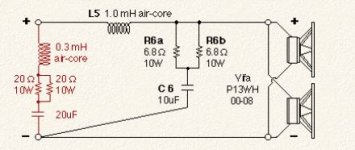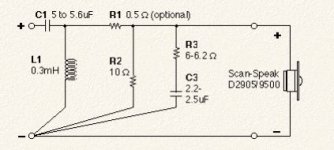Isn't the Usher just a pair of commodity drivers in a nice looking box? It seems that many could build a comparative set of speakers and try it out. Just list the driver models and I imagine those are available in many countries.
As seems very likely from previous discussions, the difference probably is mainly caused by the amp reacting differently to a flat impedance. Which means the effect is not specific to this particular speaker.
With that in mind we could test the hypothesis with any reasonable speaker, as long as it has a 'wild' impedance curve.
Jan
Joe you were asking how common-mode distortion works in amplifiers, having dealt with transistor Class AB crossover distortion. It's noise from the Earth Rail that finds its way into the signal input.
No. Common mode is just what it says: it is a signal that is the same on both inputs (the signal input as well as the feedback input).
As such a signal goes up and down, both inputs go up and down identically and in an ideal setting, there would be no output signal from the amp.
Of course things are not ideal and there WILL be an output signal. How much, depends on the common mode suppression capabilities of the amp.
Common mode distortion is when the presence of that 'both-sides-equal' signal causes distortion of the wanted signal (logically called differential signal). In transistor input stages for instance this is caused by the fact that the input impedance changes with input level. But that's for next time 😉
Jan
If this is about the amplifier, I would never have posted the alternative Usher crossover. In my mind, this is a loudspeaker topic.
You didn't make the right measurement. FR is not enough to dismiss the amplifier.
If this has nothing to do with the amplifier then ANY amplifier will give the same result!
You didn't make the right measurement. FR is not enough to dismiss the amplifier.
If this has nothing to do with the amplifier then ANY amplifier will give the same result!
Source impedance of the amp which does in fact affect the frequency response.
Source impedance of the amp which does in fact affect the frequency response.
With the additional network to flatten impedance any amplifier will give approx. the same FR. The small peak at the bottom end is not relevant in listening mode as the room modes will totally dominate at those frequencies.
However one should at least verify the impedance looking from the drivers into the amplifier or make measurements in the time domain where differences between current drive and voltage drive are better seen.
With the additional network to flatten impedance any amplifier will give approx. the same FR.
Yes, but network vs no network will give a different frequency response.
Yes, but network vs no network will give a different frequency response.
That is for sure. However I would not think that the added components are the only responsible for the different sound. The improved clarity he is talking about in my opinion is mostly due to better dynamics of the current drive. In systems where there is no crossover this is quite striking.
I would try to measure a CSD plot with 30-40 dB scaling, for example. The starting FR might be about the same with two different amps but not necessarily the decay. Which one is cleaner?
I now am confused about what it is that we want to compare. Is it a speaker with and without flattening network, driven by a voltage amp?
Or is it a speaker with and without flattening network, driven by a current source?
Or a combination - and then, which combination?
Jan
Or is it a speaker with and without flattening network, driven by a current source?
Or a combination - and then, which combination?
Jan
I just want to reiterate what I have said a number of times:
IF this is making an audible difference, then we have concluded that the improvement is not to do with the amplifier, but rather that of the speaker itself.
I only use the IF world because of those who not heard the benefit. The most I have claimed is that there is a noticeable improvement in 'clarity' and I have not been making outlandish claims using flowery speech or lots of wonderful adjectives. All that has been claimed is that it is a benefit and I would prefer people to describe what they hear in their own words.
Since more than a dozen designs are out there and in various hands, with all kinds of different amplifiers, indeed we have also tried it with wildly different topologies, indeed I have here three more than average sounding amplifiers, tubes, solid state, Class D and the transconductance amplifier design published here with a 270 Ohm output impedance.
From zero to 270 Ohm, this is how much the response deviates:
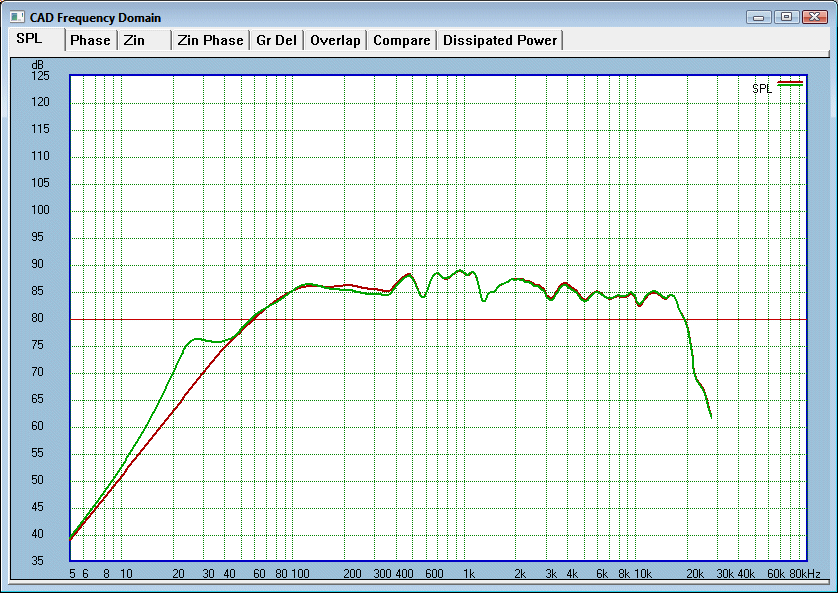
Red is zero Ohm and Green is 270 Ohm.
Now let's look at how this affects the crossover:

So the crossover is LOCKED IN.
Look carefully, there are TWO lines overlayed and you can hardly tell them apart in the crossover region. At least from an engineering point of view, that has to be some kind of achievement.
Can you imagine what it would look like with the standard Usher crossover.
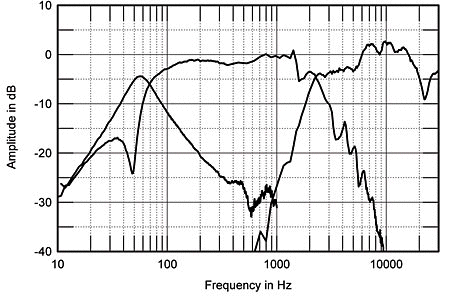
This is how it looked - but add 270 Ohm, what do you think would happen to those crossover curves. It would be a disaster!
So, here is proof, that we do not hear any tonal balance nor are there any audible frequency response changes, from zero Ohm to 270 Ohm. The Hypex NC400 Class D amps (very good indeed and a bargain) has, I believe, an output impedance of 0.1 Ohm.
---
There is another nice little thing to point out, the DCR of the series inductor of the bass is cancelled out. Because the compensation is seen directly by the amplifier and the series inductor is compensated for, it's DCR is effectively zero in a system sense. You can, if you think it worthwhile, use a much smaller inductor with larger DCR, that is of course a design choice, but whether high or low DCR, it is accounted for.
But have to say, this works best for sealed boxes.
But coming back to the point, we have now used this type of crossover with just an infinite number of amps (number unknown) and I think I can say emphatically - the speaker is making the difference here, but of course we shall always need a more than average amplifier to show it up.
The increase in clarity is noticeable - and if you got good amps and excellent source (most digital isn't that good), it is not that hard to hear.
IF this is making an audible difference, then we have concluded that the improvement is not to do with the amplifier, but rather that of the speaker itself.
I only use the IF world because of those who not heard the benefit. The most I have claimed is that there is a noticeable improvement in 'clarity' and I have not been making outlandish claims using flowery speech or lots of wonderful adjectives. All that has been claimed is that it is a benefit and I would prefer people to describe what they hear in their own words.
Since more than a dozen designs are out there and in various hands, with all kinds of different amplifiers, indeed we have also tried it with wildly different topologies, indeed I have here three more than average sounding amplifiers, tubes, solid state, Class D and the transconductance amplifier design published here with a 270 Ohm output impedance.
From zero to 270 Ohm, this is how much the response deviates:

Red is zero Ohm and Green is 270 Ohm.
Now let's look at how this affects the crossover:

So the crossover is LOCKED IN.
Look carefully, there are TWO lines overlayed and you can hardly tell them apart in the crossover region. At least from an engineering point of view, that has to be some kind of achievement.
Can you imagine what it would look like with the standard Usher crossover.

This is how it looked - but add 270 Ohm, what do you think would happen to those crossover curves. It would be a disaster!
So, here is proof, that we do not hear any tonal balance nor are there any audible frequency response changes, from zero Ohm to 270 Ohm. The Hypex NC400 Class D amps (very good indeed and a bargain) has, I believe, an output impedance of 0.1 Ohm.
---
There is another nice little thing to point out, the DCR of the series inductor of the bass is cancelled out. Because the compensation is seen directly by the amplifier and the series inductor is compensated for, it's DCR is effectively zero in a system sense. You can, if you think it worthwhile, use a much smaller inductor with larger DCR, that is of course a design choice, but whether high or low DCR, it is accounted for.
But have to say, this works best for sealed boxes.
But coming back to the point, we have now used this type of crossover with just an infinite number of amps (number unknown) and I think I can say emphatically - the speaker is making the difference here, but of course we shall always need a more than average amplifier to show it up.
The increase in clarity is noticeable - and if you got good amps and excellent source (most digital isn't that good), it is not that hard to hear.
Last edited:
I just want to reiterate what I have said a number of times:
You have to reiterate because what you told is not clear. The FR measurements are clear but, once it's clear that FR doesn't change from one amp to the other, such measurements don't tell anything about the sound and do not allow you to rule out the amplifier! Sorry. If everything was down to FR variations the HiFi hobby would not exist anymore.....
So is the sound the SAME with the three different amplifiers of YOURS? If yes than you can rule the amp out if not then you can't. It is as simple as that.
I understand the amp still makes a difference so you can only tell I can hear an improvement but it will depend from case to case. Again you cannot rule the amp out...
The increase in clarity is noticeable - and if you got good amps and excellent source (most digital isn't that good), it is not that hard to hear.
You first need a good room.
You have to reiterate because what you told is not clear. The FR measurements are clear but, once it's clear that FR doesn't change from one amp to the other, such measurements don't tell anything about the sound and do not allow you to rule out the amplifier! Sorry. If everything was down to FR variations the HiFi hobby would not exist anymore.....
So is the sound the SAME with the three different amplifiers of YOURS? If yes than you can rule the amp out if not then you can't. It is as simple as that.
I understand the amp still makes a difference so you can only tell I can hear an improvement but it will depend from case to case. Again you cannot rule the amp out...
You first need a good room.
It is the amplifier working better into a resistive load. Lower distortion for several reasons. No doubt in my mind at all. 😎
Look at the original impedance corrected speaker circuit:

Without impedance correction the top end is just like one of my own rough sounding disasters:
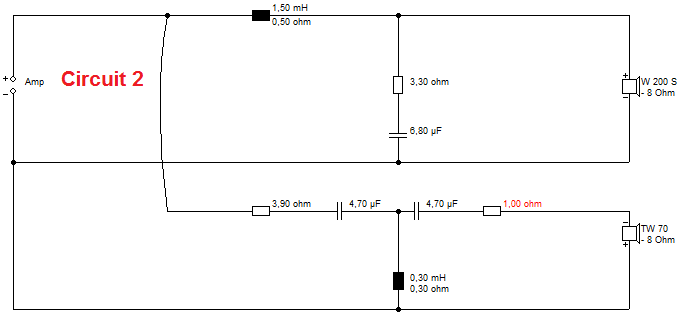
Because the impedance goes almost infinite at ultrasonic frequency, before the amp Zobel kicks in. Because the tweeter goes inductive. Easy to fix, once I knew what the problem was. A Zobel or a simple resistor can do this.
The Current/Voltage/Feedback/No Feedback amplifier part is a red herring. They all work the same into a RESISTIVE FLAT load. Which is what Joe is saying really.
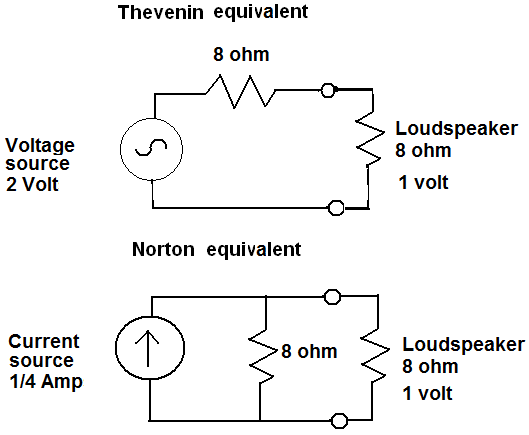
(deleted some of the stuff)I only use the IF world because of those who not heard the benefit. The most I have claimed is that there is a noticeable improvement in 'clarity' and I have not been making outlandish claims using flowery speech or lots of wonderful adjectives. All that has been claimed is that it is a benefit and I would prefer people to describe what they hear in their own words.
So the crossover is LOCKED IN.
Look carefully, there are TWO lines overlayed and you can hardly tell them apart in the crossover region. At least from an engineering point of view, that has to be some kind of achievement.
Can you imagine what it would look like with the standard Usher crossover.
So, here is proof, that we do not hear any tonal balance nor are there any audible frequency response changes, from zero Ohm to 270 Ohm. The Hypex NC400 Class D amps (very good indeed and a bargain) has, I believe, an output impedance of 0.1 Ohm.
---
There is another nice little thing to point out, the DCR of the series inductor of the bass is cancelled out. Because the compensation is seen directly by the amplifier and the series inductor is compensated for, it's DCR is effectively zero in a system sense. You can, if you think it worthwhile, use a much smaller inductor with larger DCR, that is of course a design choice, but whether high or low DCR, it is accounted for.
But have to say, this works best for sealed boxes.
But coming back to the point, we have now used this type of crossover with just an infinite number of amps (number unknown) and I think I can say emphatically - the speaker is making the difference here, but of course we shall always need a more than average amplifier to show it up.
The increase in clarity is noticeable - and if you got good amps and excellent source (most digital isn't that good), it is not that hard to hear.
To me those graphs look like the major difference is in the woofers lowpass. JR's version has smoother roll-off and thus obviously better phase match. 4kHz (resonance peak) of woofer is 15dB down in original, only 10dB down with JR's
I accept also the smoother impedance /phase angle making the load easier for the amp. But I have no idea about how that would make the sound cleaner -distortion?
Last edited:
I just want to reiterate what I have said a number of times:
IF this is making an audible difference, then we have concluded that the improvement is not to do with the amplifier, but rather that of the speaker itself.
I only use the IF world because of those who not heard the benefit. The most I have claimed is that there is a noticeable improvement in 'clarity' and I have not been making outlandish claims using flowery speech or lots of wonderful adjectives. All that has been claimed is that it is a benefit and I would prefer people to describe what they hear in their own words.
Since more than a dozen designs are out there and in various hands, with all kinds of different amplifiers, indeed we have also tried it with wildly different topologies, indeed I have here three more than average sounding amplifiers, tubes, solid state, Class D and the transconductance amplifier design published here with a 270 Ohm output impedance.
From zero to 270 Ohm, this is how much the response deviates:

Red is zero Ohm and Green is 270 Ohm.
Now let's look at how this affects the crossover:

So the crossover is LOCKED IN.
Look carefully, there are TWO lines overlayed and you can hardly tell them apart in the crossover region. At least from an engineering point of view, that has to be some kind of achievement.
Can you imagine what it would look like with the standard Usher crossover.

This is how it looked - but add 270 Ohm, what do you think would happen to those crossover curves. It would be a disaster!
So, here is proof, that we do not hear any tonal balance nor are there any audible frequency response changes, from zero Ohm to 270 Ohm. The Hypex NC400 Class D amps (very good indeed and a bargain) has, I believe, an output impedance of 0.1 Ohm.
---
There is another nice little thing to point out, the DCR of the series inductor of the bass is cancelled out. Because the compensation is seen directly by the amplifier and the series inductor is compensated for, it's DCR is effectively zero in a system sense. You can, if you think it worthwhile, use a much smaller inductor with larger DCR, that is of course a design choice, but whether high or low DCR, it is accounted for.
But have to say, this works best for sealed boxes.
But coming back to the point, we have now used this type of crossover with just an infinite number of amps (number unknown) and I think I can say emphatically - the speaker is making the difference here, but of course we shall always need a more than average amplifier to show it up.
The increase in clarity is noticeable - and if you got good amps and excellent source (most digital isn't that good), it is not that hard to hear.
I don't know how you can sit there with a straight face and present FR curves with differences of a dB or so in the 200 to 400 Hz octave and claim there is no audible difference. You claim you don't hear a difference so that is proof? The only thing that might prove is your ability to discern audible differences of that magnitude. It doesn't follow that no one else can. Stop blowing smoke up my ***.
Last edited:
So Joe, is this '270 ohms' the series resistor added to the amp output to move it more toward current drive, right?
Is this with the stock crossover? With or without the flattening network?
Jan
Is this with the stock crossover? With or without the flattening network?
Jan
It really is time to stop asking Joe to justify or explain everything here. You either get it or you don't about impedance correction or the reasons why it is a good idea.
Lynn Olson is someone who respects what Joe is doing.
His Ariel incorporates a lot of the same ideas.
The Ariel, Part II
Now do you see it? 🙂
Lynn Olson is someone who respects what Joe is doing.
His Ariel incorporates a lot of the same ideas.
The Ariel, Part II
Now do you see it? 🙂
Attachments
Again you cannot rule the amp out...
Huh?
I can only assume you didn't read my post correctly, may I please ask that you do.
I didn't rule the amp out in toto - I simply responded to comments that said that frequency response changes was the reason for the sound changes. They are NOT. You have just confirmed that, so you confirmed that I have proved that is not the case. So please, maybe reconsider your comments. Mine are are about as clear as can be made.
I never rule out the amplifier - most aren't that good.
Again, this 'social media' stuff is seriously flawed when you can say one thing and be accused of saying the opposite. I don't think I will ever get used to that.
Lynn Olson is someone who respects what Joe is doing.
His Ariel incorporates a lot of the same ideas.
This is a photo from the European Triode Festival 2004:

That is Lynn Olson on the left. The guy behind the camera was moi. 😀
The topic that was being discussed? Not allowed to bring it up as it's against diy.audio rules. 😉
PS: The other two is John Atwood (middle) and Gary Dahl.
Last edited:
...frequency response changes was the reason for the sound changes. They are NOT.
How have you determined this? As John pointed out, the frequency response changes in you data are significant and right where human ears have high sensitivity.
How have you determined this? As John pointed out, the frequency response changes in you data are significant and right where human ears have high sensitivity.
Kind of back to square one, the basics of level matched DBT.
- Status
- Not open for further replies.
- Home
- Loudspeakers
- Multi-Way
- Joe Rasmussen Usher S520 "Current Compatible" Crossover
